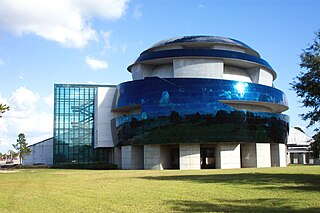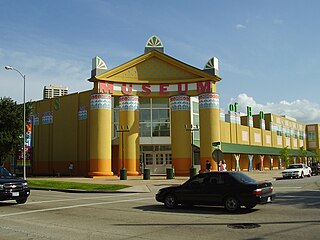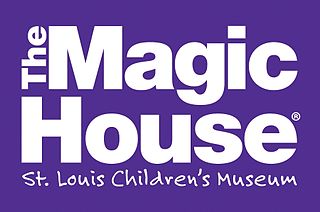
A museum is a building or institution that cares for and displays a collection of artifacts and other objects of artistic, cultural, historical, or scientific importance. Many public museums make these items available for public viewing through exhibits that may be permanent or temporary. The largest museums are located in major cities throughout the world, while thousands of local museums exist in smaller cities, towns, and rural areas. Museums have varying aims, ranging from the conservation and documentation of their collection, serving researchers and specialists, to catering to the general public. The goal of serving researchers is not only scientific, but intended to serve the general public.
The Oregon Museum of Science and Industry is a science and technology museum in Portland, Oregon, United States. It contains three auditoriums, including a large-screen theatre, planetarium, and exhibition halls with a variety of hands-on permanent exhibits focused on natural sciences, industry, and technology. Transient exhibits span a wider range of disciplines.

The Museum of Science & Industry (MOSI) is a non-profit science museum located in Tampa, Florida.

COSI, officially the Center of Science and Industry, is a science museum and research center in Columbus, Ohio. Originally, COSI was opened to public on 29 March 1964 and remained there for 35 years. In 1999, COSI was moved to a 320,000-square-foot (30,000 m2) facility designed by Japanese architect Arata Isozaki along a bend in the Scioto River in the Franklinton neighborhood. COSI features more than 300 interactive exhibits throughout themed exhibition areas.

The Children's Museum of Indianapolis is the world's largest children's museum. It is located at 3000 North Meridian Street, Indianapolis, Indiana, United States, in the United Northwest Area neighborhood of the city. The museum is accredited by the American Alliance of Museums. It is 472,900 square feet (43,933.85 m2) with five floors of exhibit halls and receives more than one million visitors annually. Its collection of over 130,000 artifacts and exhibit items is divided into two domains: Arts & Humanities and the Natural Sciences. Among the exhibits are a simulated Cretaceous dinosaur habitat, a carousel, a steam locomotive, and the glass sculpture Fireworks of Glass Tower and Ceiling. The museum's focus is family learning; most exhibits are designed to be interactive, allowing children and families to actively participate.

The Boonshoft Museum of Discovery is a children's museum, science and technology center and zoo in Dayton, Ohio, United States that focuses on science and natural history. Exhibits include an extensive natural history collection as well as maintaining a collection of live animals native to Ohio and abroad. Educational outreach extends to the community by providing in-school programming and on-site special programs. SunWatch Indian Village and Fort Ancient are the sister sites to the museum.

Self-Help Graphics & Art, Inc. is a community arts center with a mix Beaux-Arts and vernacular architecture in East Los Angeles, California, United States. The building was built in 1927, and was designed by Postle & Postle. Formed during the cultural renaissance that accompanied the Chicano Movement, Self Help, as it is sometimes called, was one of the primary centers that incubated the nascent Chicano art movement, and remains important in the Chicano art movement, as well as in the greater Los Angeles community, today. SHG also hosts musical and other performances, and organizes Los Angeles's annual Day of the Dead festivities. Throughout its history, the organization has worked with well-known artists in the Los Angeles area such as Los Four and the East Los Streetscapers, but it has focused primarily on training and giving exposure to young and new artists, many of whom have gone on to national and international prominence.

The Orlando Science Center (OSC) is a private science museum located in Orlando, Florida. Its purposes are to provide experience-based opportunities for learning about science and technology and to promote public understanding of science.

Kidspace Children's Museum is a children's museum in Pasadena, California. It is located next to the Rose Bowl, in the former Fannie E. Morrison Horticultural Center.

Children's Museum Houston (CMH) is a children's museum in the Museum District in Houston, Texas. Founded in 1980 and housed in a building designed by Robert Venturi, it offers a multitude of innovative exhibits and bilingual learning programs for kids ages birth to 12 years. It serves more than 1,400,000 people annually and operates as a 501(c)(3) under the direction of a Board of Directors. It is one of 190 children's museums in the United States and 15 children's museums in Texas.
Hand in Hand: Center for Jewish-Arab Education in Israel is a network of integrated, bilingual schools for Jewish and Arab children in Israel. Hand in Hand was co-founded by Israeli Arab educator Amin Khalaf and Israeli American educator Lee Gordon in 1997 with 50 students at two campuses.

Discovery Place Science is a science and technology museum designed for all ages, located in Uptown, Charlotte, North Carolina. The facility's exhibits and activities focus on hands-on experiences; it features a "Thinker Space" and labs, a two story urban rain forest, aquariums, live animal exhibits, stages for demonstrations, space for traveling exhibits, and event space. Discovery Place Science also operates The Charlotte Observer IMAX Dome Theater, also referred to as an OMNIMAX theater. It is the largest IMAX Dome Theater in the Carolinas.

Discovery Station, is a hands-on, family-friendly museum in downtown Hagerstown, Maryland, United States that opened to the public in 2005. The museum's focus is to create an environment that stimulates curiosity for discovery, exploration, and further investigation through exhibits and programs that focus on Science, Technology, Engineering, Art, and Math (STEAM) principles. The museum is a member of the Association of Science and Technology Centers (ASTC), the American Alliance of Museums (AAM), and the NASA Museum Alliance.

The Exploratorium is a museum of science, technology, and arts in San Francisco, California. Characterized as "a mad scientist's penny arcade, a scientific funhouse, and an experimental laboratory all rolled into one", the participatory nature of its exhibits and its self-identification as a center for informal learning has led to it being cited as the prototype for participatory museums around the world.

Herrick District Library is a public library system serving the residents of Holland, Michigan and the surrounding townships. In 2008-2009, over the course of 583,000 visits, library cardholders checked out 1.2 million items.

The Eugene Science Center, located in Alton Baker Park in Eugene, Oregon, United States, is a science and technology center for children, families, and school groups. The 10,000-square-foot (930 m2) museum near Autzen Stadium features changing interactive exhibits, planetarium shows, camp programs, special events and other science and technology-related education programs. Eugene Science Center is an independent 501(c)(3) non-profit organization governed by a volunteer board of directors. Its mission is: "To engage children, excite their curiosity, inspire them toward a lifetime love of science, and empower them to use science and technology to improve their communities." Eugene Science Center is the only science museum in Lane County and surrounding counties.
A mobile museum is a museum educational outreach program that bring the museum to the people rather than vice versa. Typically they can be in Recreational Vehicles (RVs) or trucks/trailers that drive to schools, libraries and rural events. Their business model is to use grant or donor support, as they goal is to make the museum exhibit accessible to underserved populations. Below are some examples of mobile museums.

The Flint Institute of Arts, also called FIA, is located in the Flint Cultural Center in Flint, Michigan. The second largest art museum in Michigan, it offers exhibitions, interpretive programs, film screenings, concerts, lectures, family events and educational outreach programs to people of various ages, serving over 160,000 adults and children a year.

The Da Vinci Science Center (DSC) is a science museum and nonprofit organization in Allentown, Pennsylvania. The center has been a leader in "bringing science to life and lives to science", according to its mission statement, since its 1992 founding.

The Magic House is a not-for-profit children's museum located in Kirkwood, Missouri, just outside St. Louis. The Magic House opened as a children's museum in 1979 with the mission of engaging children in hands-on learning experiences that encourage experimentation, creativity and the development of problem-solving skills within a place of beauty, wonder, joy and magic. Since the opening of the Museum in 1979, The Magic House has undergone a series of additions and renovations that have expanded the Museum space from 5,500 square feet to 55,000 square feet (5,100 m2). The Magic House has gained recognition as one of the nation's top children's museums, and was ranked the nation's #1 attraction based on child appeal by Zagat U.S. Family Travel Guide. The Museum attracts more than 560,000 visitors per year and since its opening has been visited by more than 12 million people.

















